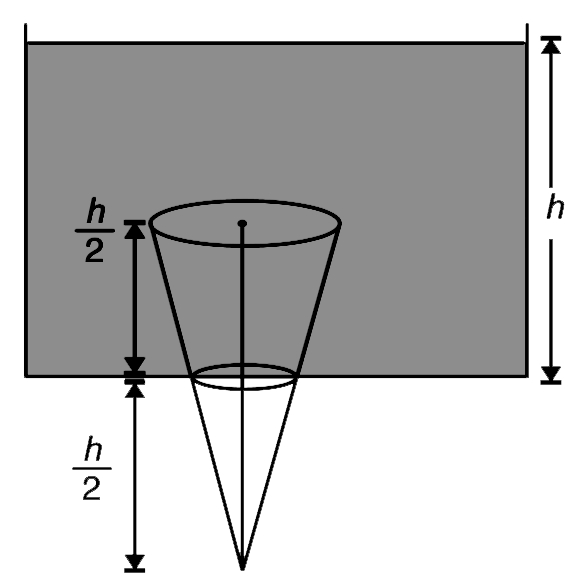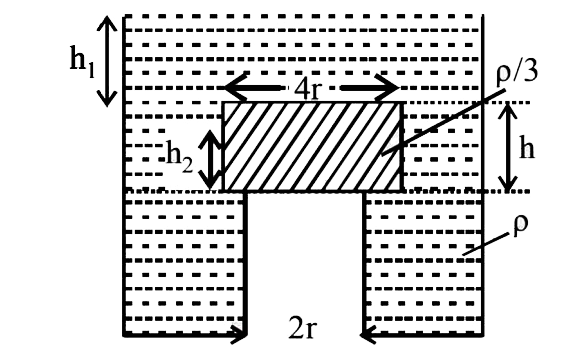A water tanker filled up to 23 of its height is moving with a uniform speed. On sudden application of the brake, the water in the tank would
move backward
move forward
be unaffected
rise upwards
The correct Answer is:B
On sudden application of brakes, water in the tank would move forward due to inertia of motion.
Topper's Solved these Questions
- BOOK - PRADEEPCHAPTER - FORCES AND LAWS OF MOTIONEXERCISE - MOCK TEST36videos
FORCES AND LAWS OF MOTION
- BOOK - PRADEEPCHAPTER - FORCES AND LAWS OF MOTIONEXERCISE - ASSESSSMENT THROUGH PAPER-PEN TEST29videos
FORCES AND LAWS OF MOTION
- BOOK - PRADEEPCHAPTER - FLOTATIONEXERCISE - Problem For Practice6videos
FLOTATION
- BOOK - PRADEEPCHAPTER - GRAVITATIONEXERCISE - Model Test paper (1)36videos
GRAVITATION
Similar Questions
A motor car moving with a uniform speed of 20 m/sec comes to stop on the application of brakes after travelling a distance of 10m, its deceleration is
View SolutionA water tank has a circular hole at its base. A solid cone is used to plug the hole. Exactly half the height of the cone protrudes out of the hole. Water is filled in the tank to a height equal to height of the cone. Caluclate the buoyancy force on the conc. Density of water is ρ and volume of cone is V.
 View Solution
View Solution
Knowledge Check
- Question 1 - Select One
A water tanker filled up to 2/3 of its heights is moving with a uniform speed. On sudden application of the brake, the water in the tank would
Amove backwardBmove forward and riseCbe unaffectedDmove backward and rise - Question 2 - Select One
A water tanker filled up to two-thirds of its tank with water is running with a uniform speed. When the brakes are suddenly applied, the water in its tank would:
Amove backwardBmove forwardCrise upwardsDremain unaffected - Question 3 - Select One
A motor car moving with a uniform speed of 20m/sec comes to stop on the application of brakes after travelling a distance of 10m Its acceleration is
A20m/sec2B−20m/sec2C−40m/sec2D+2m/sec2
Solve :
Sandeep filled water in 45th of an empty tank. After that, Ramakant filled 14 th part more of the same tank. Then Umesh used 314 th part of the tank to water the garden. If the tank has a maximum capacity of 560 litres, how much water is left in the tank now?View SolutionA 10 H.P. motor pumps out water from a well of depth 20 m and fills a water tank of volume 22380 litres at a height of 10 m from the ground. The running time of the motor to fill the empty water tank is (g=1=ms−2)
View SolutionA cylindrical tank has a hole of diameter 2r in its bottom. The hole is covered wooden cylindrical block of diameter 4r, height h and density ρ/3.

Situation I: Initially, the tank is filled with water of density ρ to a height such that the height of water above the top of the block is h1 (measured from the top of the block).
Situation II: The water is removed from the tank to a height h2 (measured from the bottom of the block), as shown in the figure. The height h2 is smaller than h (height of the block) and thus the block is exposed to the atmosphere.
Find the height of the water level h2 (in situation 2), for which the block remains in its origin) position whithout the application of any external forceView SolutionA rectangular tank is placed on a horizontal ground and is filled with water to a height H above the base. A small hole is made on one vertical side at a depth D below the level of the water in the tank. The distance x from the bottom of the tank at which the water jet from the tank will hit the ground is
View SolutionA cylindrical tank has a hole of diameter 2r in its bottom. The hole is covered wooden cylindrical block of diameter 4r, height h and density ρ/3.

Situation I: Initially, the tank is filled with water of density ρ to a height such that the height of water above the top of the block is h1 (measured from the top of the block).
Situation II: The water is removed from the tank to a height h2 (measured from the bottom of the block), as shown in the figure. The height h2 is smaller than h (height of the block) and thus the block is exposed to the atmosphere.
Find the height of the water level h2 (in situation 2), for which the block remains in its origin) position whithout the application of any external forceView Solution

